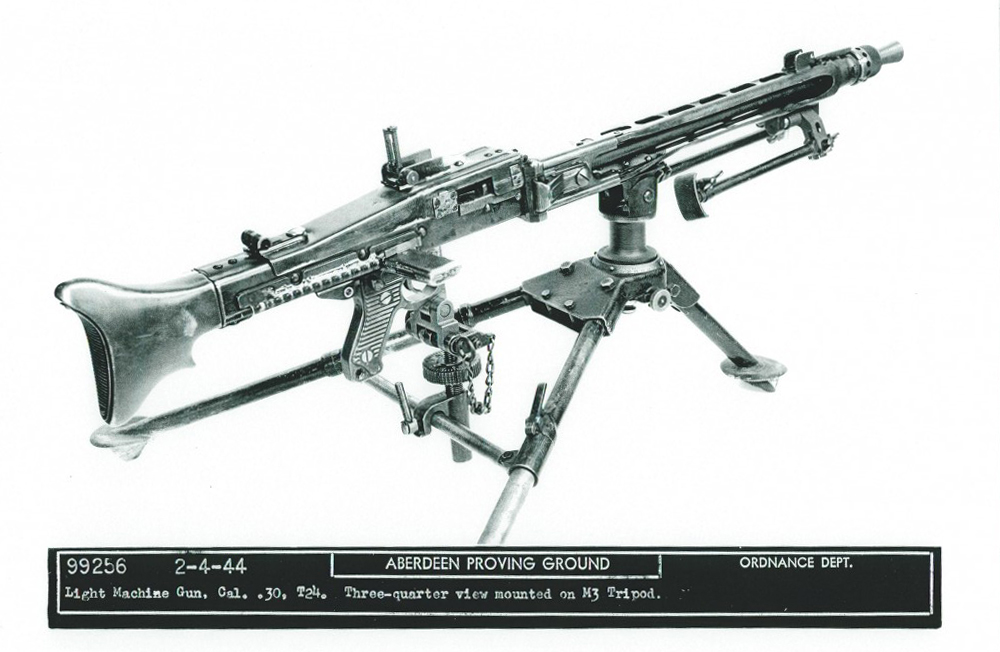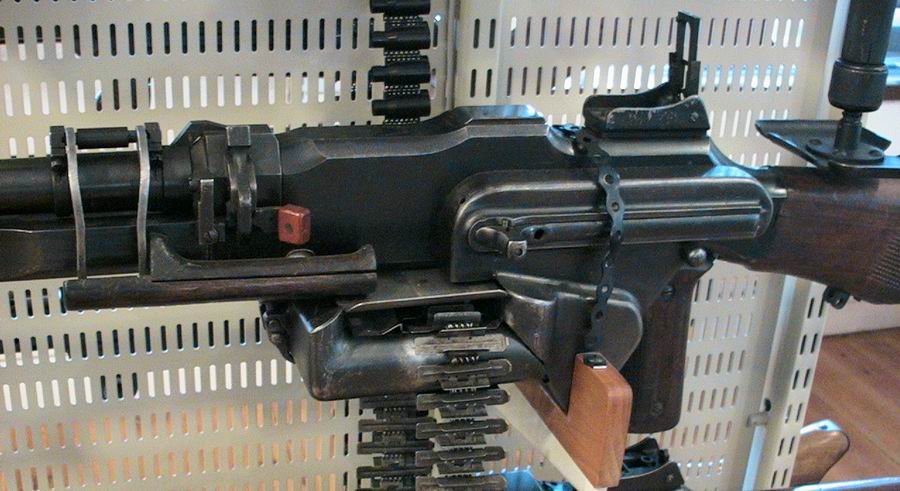Deleted member 1487
Right, had a brain fart about the US use of .50 for the HMG role.I doubt the US would have used it as a HMG. They have the superb M2HB for that role
Right, had a brain fart about the US use of .50 for the HMG role.I doubt the US would have used it as a HMG. They have the superb M2HB for that role
The T23 was three pounds heavier than the M60, but it was also chambered for .30-06 rather than .308. Reducing the length of the receiver and removing the rate-reducer would save quite a bit of weight without going to the measures the M60 design took to reduce weight. The M60's reliability, in part attributable to its lightly designed parts, was a problem throughout its service life. In fact, it was so problematic that the Army decided to replace the M60 with the M240, a gun that was six inches longer and four pounds heavier.The T-23 was designed as a light machine gun, but was heavier than the M60. It might have been adaptable as a MMG/HMG, but it most certainly would have been a poor substitute for the M60 as the squad automatic weapon, while potentially worse than the FN MAG as a MMG/HMG.
The M240 also was removed as a squad weapon and kept as a platoon/company MMG. It is more accurate to say the GPMG idea died with the the SAW program, as the M249 replaced the M60 as the LMG and the M240 as the MMG.The T23 was three pounds heavier than the M60, but it was also chambered for .30-06 rather than .308. Reducing the length of the receiver and removing the rate-reducer would save quite a bit of weight without going to the measures the M60 design took to reduce weight. The M60's reliability, in part attributable to its lightly designed parts, was a problem throughout its service life. In fact, it was so problematic that the Army decided to replace the M60 with the M240, a gun that was six inches longer and four pounds heavier.
Compared to other GPMGs, the T23 was not particularly heavy.
T23: 26.65 lbs
FN MAG 58: 25.99 lbs
MG 34: 26.7 lbs
MG 42: 25.57 lbs
M240B: 27.6 lbs

The testing issues that the T23 encountered happened because unfamiliar range staff were shooting the gun clean with the gas port all the way open, which of course led to accelerated parts breakage. The earlier T10 series of guns that the T23 was based on did have problems with reliability, but many of these were fixed by the time the T23 was tested. Furthermore, I have found primary sources citing the weight of the T23 as 22.5 lbs, which would indicate that the 26.65 lbs figure would include a full 100 rd belt. Also, the T24 machine gun was somewhat heavier than the original MG 42, negating some of that advantage. Finally, the US Army never did "develop a more modern, entirely new weapon" until the arrival of the M60 and continued to issue the M1919A6, which weighed 33 lbs, until the 1960s.clearly the army has issues with it if they chose not to pursue it and instead develop a more modern, entirely new weapon.
The M60 was designed from 1952-57 and entered service in 1957.The testing issues that the T23 encountered happened because unfamiliar range staff were shooting the gun clean with the gas port all the way open, which of course led to accelerated parts breakage. The earlier T10 series of guns that the T23 was based on did have problems with reliability, but many of these were fixed by the time the T23 was tested. Furthermore, I have found primary sources citing the weight of the T23 as 22.5 lbs, which would indicate that the 26.65 lbs figure would include a full 100 rd belt. Also, the T24 machine gun was somewhat heavier than the original MG 42, negating some of that advantage. Finally, the US Army never did "develop a more modern, entirely new weapon" until the arrival of the M60 and continued to issue the M1919A6, which weighed 33 lbs, until the 1960s.
https://en.wikipedia.org/wiki/MG_42Weight 390 oz (11.1 kg) without bipod and tripod adapter
Weight 11.6 kg (25.57 lb)[7]
The M1919A6 was only fully supplanted in US infantry service after 1960. The transition process to the M60 was, obviously, not instantaneous. The weight you give for the MG 42 includes the bipod and bipod adapter, while the weight for the T24 machine gun includes neither. The T24 had a heavier bolt to reduce the fire rate and would have also required a longer receiver, which would add weight. It is also important to note that the parts breakage problems the T23 encountered happened after several hundred rounds of full-auto fire while the T24 was never able to cycle reliably.The M60 was designed from 1952-57 and entered service in 1957.
https://en.wikipedia.org/wiki/M60_machine_gun
The T24 was actually lighter than the MG42 by .5kg:
https://en.wikipedia.org/wiki/T24_machine_gun
https://en.wikipedia.org/wiki/MG_42
I do appreciate the Taden's Bren gun heritage and I think it would have been a formidable squad-level weapon. However, while the .280 British cartridge would have been great for the infantry squad, it would have been underpowered for the full range of GPMG roles, especially for vehicle or aircraft mountings. Though this would have been a problem, it wouldn't have arisen at the squad, and possibly at the platoon, level. My personal opinion on the topic is that it is not possible to create an intermediate, brass-cased cartridge capable of fulfilling both the assault rifle and GPMG roles, and that the smaller intermediate cartridges like .280 British make too many sacrifices in the GPMG role to justify.I see your T23/T24 pair and raise you one British 0.270 Tanden. Though not taken beyond trials weapons status for political reasons this GPMG designed to accompany the Rifle no9 would have been a "belter" (pun intended). It is worth remembering that the .27 calibre British Bullpup weapon was to be supplied both as a long barrelled rifle and as a short barrel carbine.
Still a bit too heavy, and it still fired around 1000rpm, about twice as fast as needed.Frankly IMHO the US should have just adopted the MG3 as their GPMG in the 1950s
The M1919A6 was only fully supplanted in US infantry service after 1960. The transition process to the M60 was, obviously, not instantaneous. The weight you give for the MG 42 includes the bipod and bipod adapter, while the weight for the T24 machine gun includes neither. The T24 had a heavier bolt to reduce the fire rate and would have also required a longer receiver, which would add weight. It is also important to note that the parts breakage problems the T23 encountered happened after several hundred rounds of full-auto fire while the T24 was never able to cycle reliably.
I do appreciate the Taden's Bren gun heritage and I think it would have been a formidable squad-level weapon. However, while the .280 British cartridge would have been great for the infantry squad, it would have been underpowered for the full range of GPMG roles, especially for vehicle or aircraft mountings. Though this would have been a problem, it wouldn't have arisen at the squad, and possibly at the platoon, level. My personal opinion on the topic is that it is not possible to create an intermediate, brass-cased cartridge capable of fulfilling both the assault rifle and GPMG roles, and that the smaller intermediate cartridges like .280 British make too many sacrifices in the GPMG role to justify.
The T23 was basically a BAR flipped upside down to allow for top feed (of which belt feed is a form).Still a bit too heavy, and it still fired around 1000rpm, about twice as fast as needed.
I'm partial to the later Swedish belt fed BAR derivatives with real QD barrels

The Swedes never really adopted it because of the problems with the feed system.Still a bit too heavy, and it still fired around 1000rpm, about twice as fast as needed.
I'm partial to the later Swedish belt fed BAR derivatives with real QD barrels

The Swedes never really adopted it because of the problems with the feed system.
Also the MG3 only had 1000rpm for AA duties; it had a heavy bolt for ground duty mean 800-900 rpm, which is what the MG42 did as well.
And the first few seconds when the bad guys rush for coverReally don't need more than 5-600rpm for rifle class LMG/GPMGs
AA is the only time that rate is handy
Better to have it and not need it than need it and not have it. With trigger discipline it is probably the best MMG/GPMG ever devised...simply because they never adopted the MG45/MG60, but that is another story. If the Spanish had better built the Ameli (effectively the MG45 in 5.56mm), it might be the best LMG/SAW out there.Really don't need more than 5-600rpm for rifle class LMG/GPMGs
AA is the only time that rate is handy
The final compromise 280/30 had a similar long range performance to the 7.62 NATO and there is very little to choose regarding performance.
Both were overpowered for the majority of infantry squad level rifle roles but were suitable as a GPMG round
I would agree with your last statement - I think .270 for Section / platoon rifles and LMGs (SAW?) and 280/30 or .30 light - or sod it stick with 30-06 for a GPMG / MMG
If we're talking about ideals, I'm still in favor of the 6mm Lee Navy updated, otherwise known as the 6mm SAW.I concur. A .270 rifle and LMG/SAW be perfect at platoon level. Full power round be fine for GPMG/MMG. Wether 280/30, 308, or 30-06 honestly doesn't matter too much in that role. Or for that matter mouser 8mm too for countries that preferred it.
Ah the 6mm lee navy. Always liked that round, it just was a little to advanced for it's time... Ok maybe more then a little. But with more modern barrels, better manufacturing Ect it could be a nice cartridge.If we're talking about ideals, I'm still in favor of the 6mm Lee Navy updated, otherwise known as the 6mm SAW.
Cannot think of many MGs that use lever delayed blowback. Must be a highly interesting weapon.
Only one I can think of, it served from 1957-2010s, so must have worked.Cannot think of many MGs that use lever delayed blowback. Must be a highly interesting weapon.